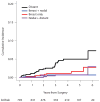Axillary Dissection and Nodal Irradiation Can Be Avoided for Most Node-positive Z0011-eligible Breast Cancers: A Prospective Validation Study of 793 Patients
- PMID: 28650355
- PMCID: PMC5649371
- DOI: 10.1097/SLA.0000000000002354
Axillary Dissection and Nodal Irradiation Can Be Avoided for Most Node-positive Z0011-eligible Breast Cancers: A Prospective Validation Study of 793 Patients
Abstract
Objective: To determine rates of axillary dissection (ALND) and nodal recurrence in patients eligible for ACOSOG Z0011.
Background: Z0011 demonstrated that patients with cT1-2N0 breast cancers and 1 to 2 involved sentinel lymph nodes (SLNs) having breast-conserving therapy had no difference in locoregional recurrence or survival after SLN biopsy alone or ALND. The generalizability of the results and importance of nodal radiotherapy (RT) is unclear.
Methods: Patients eligible for Z0011 had SLN biopsy alone. Prospectively defined indications for ALND were metastases in ≥3 SLNs or gross extracapsular extension. Axillary imaging was not routine. SLN and ALND groups and radiation fields were compared with chi-square and t tests. Cumulative incidence of recurrences was estimated with competing risk analysis.
Results: From August 2010 to December 2016, 793 patients met Z0011 eligibility criteria and had SLN metastases. Among them, 130 (16%) had ALND; ALND did not vary based on age, estrogen receptor, progesterone receptor, or HER2 status. Five-year event-free survival after SLN alone was 93% with no isolated axillary recurrences. Cumulative 5-year rates of breast + nodal and nodal + distant recurrence were each 0.7%. In 484 SLN-only patients with known RT fields (103 prone, 280 supine tangent, 101 breast + nodes) and follow-up ≥12 months, the 5-year cumulative nodal recurrence rate was 1% and did not differ significantly by RT fields.
Conclusions: We confirm that even without preoperative axillary imaging or routine use of nodal RT, ALND can be avoided in a large majority of Z0011-eligible patients with excellent regional control. This approach has the potential to spare substantial numbers of women the morbidity of ALND.
Figures
Comment in
-
Omission of Regional Nodal Irradiation in Patients With Sentinel Lymph Node Positive Patients: "The Believer is Happy while the Doubter is Wise".Ann Surg. 2018 Dec;268(6):e53-e54. doi: 10.1097/SLA.0000000000002571. Ann Surg. 2018. PMID: 29135496 No abstract available.
References
-
- Rescigno J, Zampell JC, Axelrod D. Patterns of axillary surgical care for breast cancer in the era of sentinel lymph node biopsy. Ann Surg Oncol. 2009;16(3):687–96. - PubMed
-
- Giuliano AE, Ballman K, McCall L, et al. Locoregional Recurrence After Sentinel Lymph Node Dissection With or Without Axillary Dissection in Patients With Sentinel Lymph Node Metastases: Long-term Follow-up From the American College of Surgeons Oncology Group (Alliance) ACOSOG Z0011 Randomized Trial. Ann Surg. 2016;264(3):413–20. - PMC - PubMed
-
- Goyal A, Dodwell D. POSNOC: A Randomised Trial Looking at Axillary Treatment in Women with One or Two Sentinel Nodes with Macrometastases. Clin Oncol (R Coll Radiol) 2015;27(12):692–5. - PubMed
-
- Guth U, Myrick ME, Viehl CT, et al. The post ACOSOG Z0011 era: does our new understanding of breast cancer really change clinical practice? Eur J Surg Oncol. 2012;38(8):645–50. - PubMed
Publication types
MeSH terms
Grants and funding
LinkOut - more resources
Full Text Sources
Other Literature Sources
Medical
Molecular Biology Databases
Research Materials
Miscellaneous


